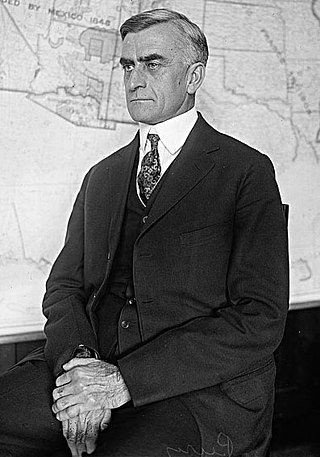Top Qs
Timeline
Chat
Perspective
George C. Peery
American politician From Wikipedia, the free encyclopedia
Remove ads
George Campbell Peery (October 28, 1873 – October 14, 1952) was a Virginia lawyer, school principal and Democratic politician, who served as the 52nd governor of Virginia from 1934 to 1938, after serving three terms in the U.S. House of Representatives, as well as on the State Corporation Commission. Sometimes called the second governor selected (at least partially), by the soon to be very powerful Byrd Organization, led by former Virginia Governor and later multi-term Senator Harry F. Byrd, Sr.[1] Peery was also the first Virginia governor from southwest Virginia, and noted his descent from early settlers of the Clinch Valley.[2]
This article needs additional citations for verification. (April 2016) |
Remove ads
Early life and education
Summarize
Perspective
Peery was born in Cedar Bluff, in Tazewell County, Virginia, in the far southwest portion of the state. Ancestors had settled in the area after the American Revolutionary War.,[3] and Dr. Andrew Peery had served as in the Virginia House of Delegates in 1805-1807, and several relatives in the War of 1812.[4] His father, Dr. James Peery, had been a surgeon in Derrick's Battalion of the Confederate States Army. He attended local schools while working on his father's farm and at the family store as well as the Tazewell County Clerk's office. He later noted his experience at collecting debts for his father and uncle, beginning when he was twelve years old, and his first salaried job as assistant clerk in the Tazewell County clerk's office at $25 per month.[5] Peery attended the local public schools before attending Emory & Henry College in slightly less rural Washington County, and graduated in 1894, winning medals in oratory and science. Peery, although only twenty years old, then became principal of Tazewell High School for two years, before resigning and traveling to earn his LL.B. degree from Washington & Lee University in 1897 after a single year's study (although most students needed two years to complete it).[6]
In 1907 he married Nancy Bane Gillespie, daughter of a prominent Tazewell attorney and Republican politician, Albert P. Gillespie, who had been a delegate to the Virginia Constitutional Convention of 1902.[7][8] They had three children, Albert G. Peery (born 1908), George C. Peery, Jr.(born 1910), and Nancy Peery Whitley (born 1916).[9] Peery was also the lay leader of the Main Street Methodist Church in Tazewell, where W.P. Eastwood was pastor.[10]
Remove ads
Career
Summarize
Perspective
Peery then returned to far Southwestern Virginia to practice law, first setting up a practice in Tazewell when admitted to the Virginia bar in 1897,[11] where he later noted that he earned exactly $200 in his first twelve months of private legal practice. He decided to specialize in title work, expanding his practice to nearby Wise and Dickinson County as well as eastern Kentucky, and eventually moved to Wise, Virginia.[12] He returned to Tazewell in 1915 to settle his father in law's estate and soon joined Gillespie's former partners A.C. Buchanan and Archibald C. Chapman to form Chapman, Peery, and Buchanan.[13] He also began political involvement, chosen as Democratic elector at large on the Wilson-Marshall ticket in 1916 and in 1920 became chairman of the Ninth District Democratic committee.[14][15]
In 1922, voters in Virginia's 9th congressional district elected Peery to the United States House of Representatives. He succeeded C. Bascom Slemp, who had not sought re-election and thus became the last Republican to serve in Virginia's congressional delegation for decades. Peery defeated Republican John H. Hassinger, and two years later defeated Republican C. Henry Harman.[16] Peery's victory was considered an early test for the Byrd Organization. Peery won re-election twice, serving from 1923 to 1929 and also was a delegate to the Democratic National Convention in 1920 and 1924.
In 1929, Peery resigned to become a member of the State Corporation Commission, serving from 1929 to 1933. Then newly elected Senator Byrd approached him to run for governor in 1933. Peery accepted and won the November election.
As governor, Peery created unemployment insurance and, after the repeal of prohibition, he created Virginia's Alcohol Beverage Control board. In 1936, Governor Peery signed into law the act that created the Virginia State Parks. On June 15, 1936, Peery attended the initial opening ceremony for the six new state parks at (then whites-only) Hungry Mother State Park, in Smyth County near the Emory and Henry College campus. He was introduced by former governor E. Lee Trinkle of Wytheville, and remarked that the state park system was something good that came out of the Great Depression, and not only provided CCC jobs for those who lost them in that crisis and needed recreation space for working families, but would continue to help the local economy through tourism.[17]
After his retirement as governor, Peery joined the board of trustees of both Washington and Lee University and Hollins College.

Remove ads
Death and legacy
Peery died in 1952, at the age of 78, two weeks short of his 79th birthday, in Richlands, Virginia. He was buried in Maplewood Cemetery in Tazewell, Virginia.
In 2021, Virginia Governor Ralph Northam dedicated Clinch River State Park as the 41st Virginia state park. Although Virginia's first blueway (river-based) park is still in development, with signage and facilities being constructed in part by the Youth Conservation Corps at Sugar Hill near St. Paul in Wise County in 2023, part is in Tazewell County.
Electoral history
Summarize
Perspective
1933; Peery was elected Governor of Virginia with 73.74% of the vote, defeating Republican Fred W. McWane, Prohibitionist Andrew J. Dunning, Jr., Socialist George C. White, and Independents John Moffett Robinson and W. A. Rowe.
Remove ads
References
External links
Wikiwand - on
Seamless Wikipedia browsing. On steroids.
Remove ads

